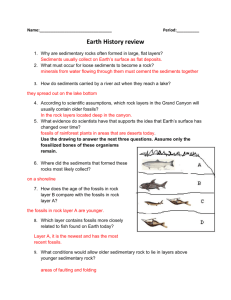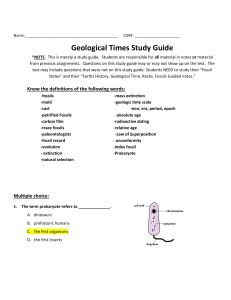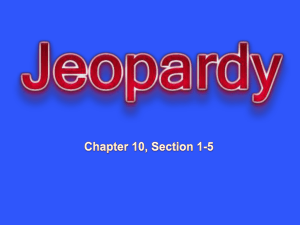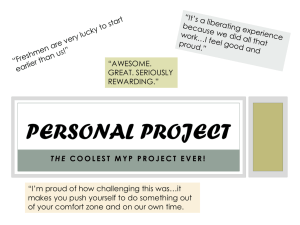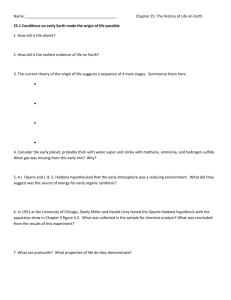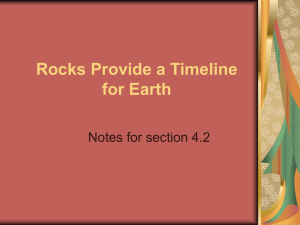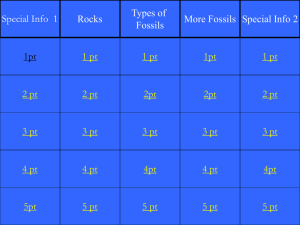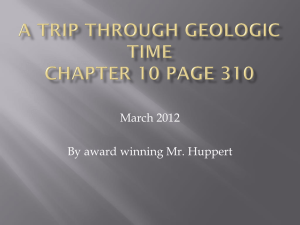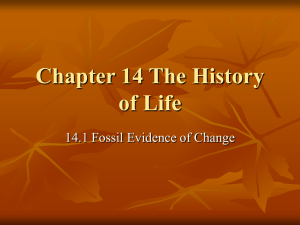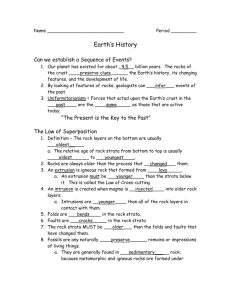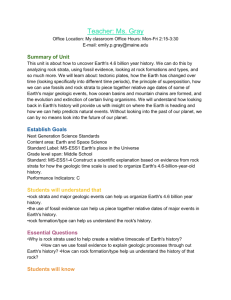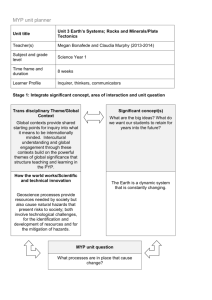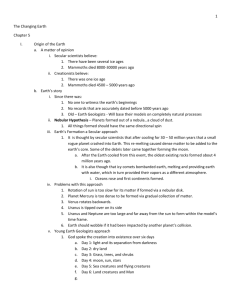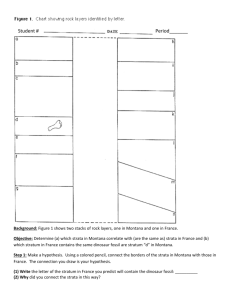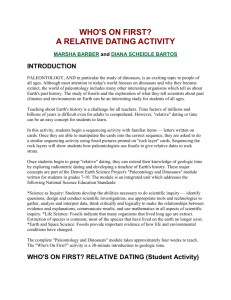MYP unit planner
advertisement
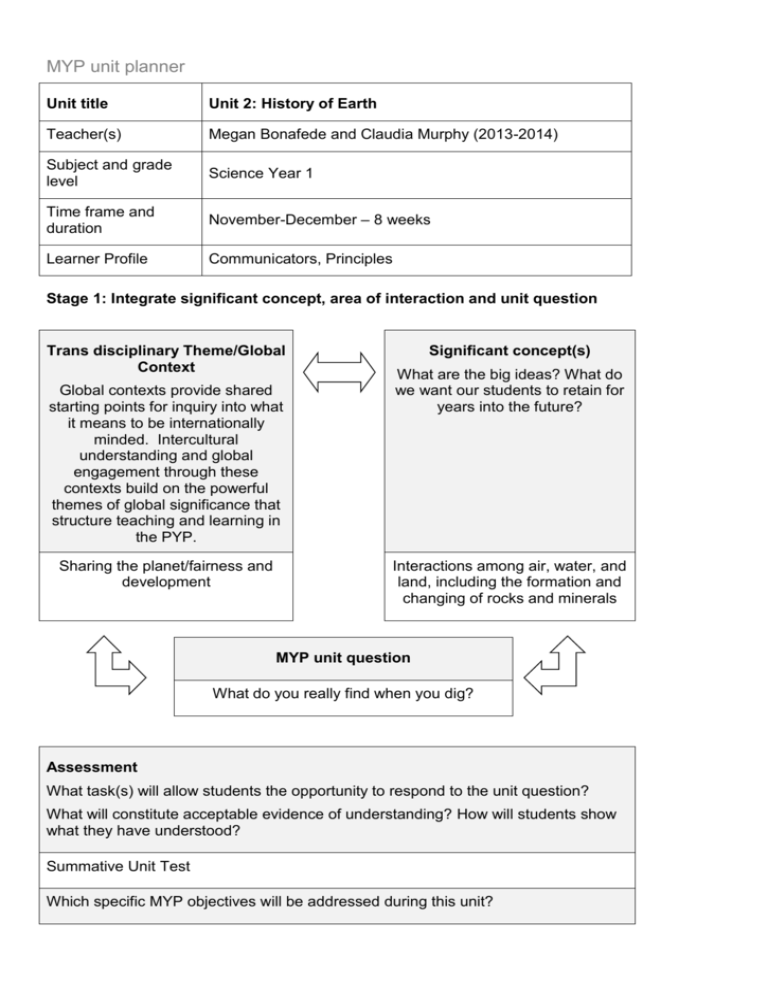
MYP unit planner Unit title Unit 2: History of Earth Teacher(s) Megan Bonafede and Claudia Murphy (2013-2014) Subject and grade level Science Year 1 Time frame and duration November-December – 8 weeks Learner Profile Communicators, Principles Stage 1: Integrate significant concept, area of interaction and unit question Trans disciplinary Theme/Global Context Global contexts provide shared starting points for inquiry into what it means to be internationally minded. Intercultural understanding and global engagement through these contexts build on the powerful themes of global significance that structure teaching and learning in the PYP. Sharing the planet/fairness and development Significant concept(s) What are the big ideas? What do we want our students to retain for years into the future? Interactions among air, water, and land, including the formation and changing of rocks and minerals MYP unit question What do you really find when you dig? Assessment What task(s) will allow students the opportunity to respond to the unit question? What will constitute acceptable evidence of understanding? How will students show what they have understood? Summative Unit Test Which specific MYP objectives will be addressed during this unit? B Communication in Science -uses scientific language correctly, consistent with the level of complexity of the units of work covered C Knowledge and understanding of Science -with guidance, recall scientific knowledge and use scientific understanding to construct scientific explanations, consistent with the level of complexity of the units of work covered Which MYP assessment criteria will be used? Criterion B: Communication in Science Criterion C: Knowledge and understanding of Science Stage 2: Backward planning: from the assessment to the learning activities through inquiry Content What knowledge and/or skills (from the course overview) are going to be used to enable the student to respond to the unit question? What (if any) state, provincial, district, or local standards/skills are to be addressed? How can they be unpacked to develop the significant concept(s) for stage 1? Enduring Understandings -fossil formation - fossils show relative ages -fossils show major events in Earth’s history such as mass extinctions, earliest evidence of life, and the last Ice Age -Earth’s history shows the formation of mountain chains and ocean basins -the evolution of extinction of living organisms - significant volcanic eruptions New York State Standards 2.1f Fossils are usually found in sedimentary rocks. Fossils can be used to study past climates and environments. 3.2a In all environments, organisms with similar needs may compete with one another for resources. 3.2b Extinction of a species occurs when the environment changes and the adaptive characteristics of a species are insufficient to permit its survival. Extinction of species is common. Fossils are evidence that a great variety of species existed in the past. 3.2c Many thousands of layers of sedimentary rock provide evidence for the long history of Earth and for the long history of changing lifeforms whose remains are found in the rocks. Recently deposited rock layers are more likely to contain fossils resembling existing species. 3.2d Although the time needed for change in a species is usually great, some species of insects and bacteria have undergone significant change in just a few years. Next Generation Science Standards MS-ESS1-4. Construct a scientific explanation based on evidence from rock strata for how the geologic time scale is used to organize Earth’s 4.6-billion-year-old history. Next Generation Science Standards Core Ideas ESS1.C: The History of Planet Earth The geologic time scale interpreted from rock strata provides a way to organize Earth’s history. Analyses of rock strata and the fossil record provide only relative dates, not an absolute scale. (MS-ESS1-4) Vocabulary Geological Time scale Model Rock strata Fossil Fossil record Sedimentary rock Absolute scale Relative dates Analysis Evolution Extinction Volcano Scientific explanation Evidence Approaches to learning How will this unit contribute to the overall development of subject-specific and general approaches to learning skills? Information Literacy -Selecting and organizing information -making connections between a variety of resources Thinking -inquiring and applying knowledge and concepts Learning experiences Teaching strategies How will students know what is expected of them? Will they see examples, rubrics, templates? How will we use formative assessment to give students feedback during the unit? How will students acquire the knowledge and practise the skills What different teaching methodologies will we employ? How are we differentiating teaching and required? How will they practise applying these? Do the students have enough prior knowledge? How will we know? General Skills: Students will follow safety procedures, use appropriate units for measured or calculated values, recognize and analyze patterns/trends, classify objects according to and established scheme, develop dichotomous key, sequence events, identify cause-and-effect relationships, and interpret results. learning for all? How have we made provision for those learning in a language other than their mother tongue? How have we considered those with special educational needs? Formative Assessments -Quick writes -labs Teaching Methods -Use of graphic organizers -Short answer responses -Cornell Notes -Philosophical Chairs -Socratic Seminars General Skills: Safely and accurately -WICOR Strategies -Other AVID Science specific strategies use the following measuring tools: metric ruler, balance, stopwatch, Differentiated Teaching graduated cylinder, thermometer, -Pre-teaching vocabulary spring scale, and voltmeter. -Graphic organizers -Use of small group read alouds -Observe past life on earth and the -Guided notes evidence-fossils -Scaffolded questions -create a geological time scale - discuss time in millions of years -examine rock layers to determine relative ages of fossils - watch video on fossil formation Resources What resources are available to us? How will our classroom environment, local environment and/or the community be used to facilitate students’ experiences during the unit? -newspapers -maps -Encarta CD -AVID Write Path Science Guide Ongoing reflections and evaluation In keeping an ongoing record, consider the following questions. There are further stimulus questions at the end of the “Planning for teaching and learning” section of MYP: From principles into practice. Students and teachers What did we find compelling? Were our disciplinary knowledge/skills challenged in any way? What inquiries arose during the learning? What, if any, extension activities arose? How did we reflect—both on the unit and on our own learning? Which attributes of the learner profile were encouraged through this unit? What opportunities were there for student-initiated action? Possible connections How successful was the collaboration with other teachers within my subject group and from other subject groups? What interdisciplinary understandings were or could be forged through collaboration with other subjects? Assessment Were students able to demonstrate their learning? How did the assessment tasks allow students to demonstrate the learning objectives identified for this unit? How did I make sure students were invited to achieve at all levels of the criteria descriptors? Are we prepared for the next stage? Data collection How did we decide on the data to collect? Was it useful? Figure 12 MYP unit planner




